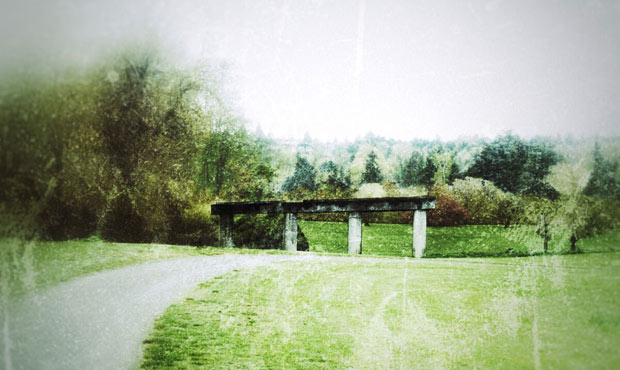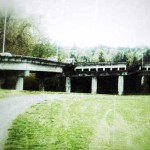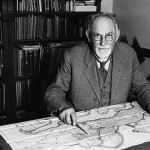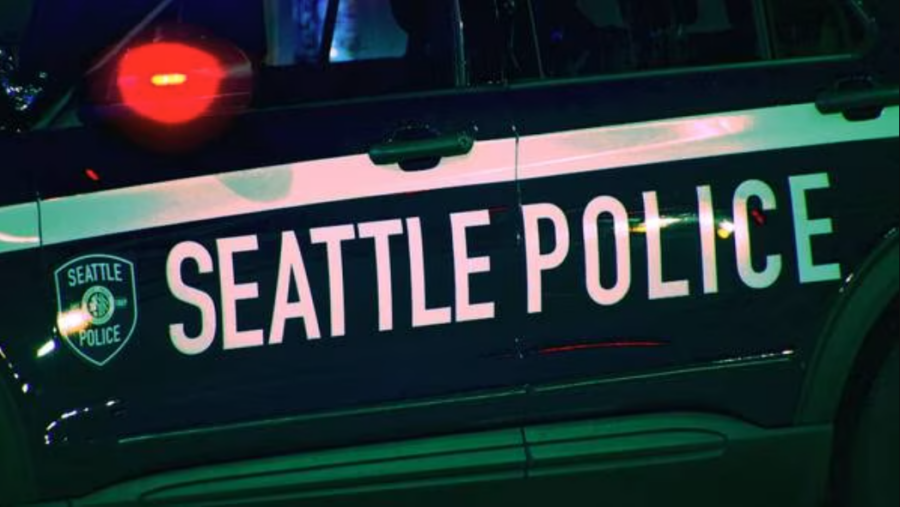Saving 520’s ramps to nowhere from demolition
Jul 6, 2016, 6:04 AM | Updated: 8:34 am

How the R.H. Thomson Expressway columns might look if preserved by Seattle ARCH. (Rainer Metzger for Seattle A.R.C.H.)
(Rainer Metzger for Seattle A.R.C.H.)
They’ve stood for more than 50 years. For some, they were a kayaking slalom course, for others, a high dive above Lake Washington. But for others, they became enormous inadvertent monuments to a freeway construction project that was shut down decades ago by citizen activists.
Now, some old concrete columns from the 520 “ramps to nowhere” near the Arboretum are being championed by a local group. They say that a small portion of the vintage columns near the lake should be preserved, in place, as a tangible reminder of the power of ordinary people to take a stand.
The eastern portion of the new 520 bridge opened earlier this year, but there’s still much to be done to construct the western portion and finish the project all the way west to I-5. Part of the remaining work includes demolition of the old 520, including the remains of the never-completed R.H. Thomson Expressway, aka the “ramps to nowhere.”
Related: Bizarre Lake Washington disaster struck 25 years ago
The Thomson Expressway would’ve cut through Madison Valley from I-90 north to 520, and then north, under Lake Washington, and eventually to State Route 522. That project was killed, famously, more than 40 years ago by a group of citizen activists who objected to what they considered needless destruction of residential neighborhoods.
Rainer Metzger is a 39-year old Garfield High and UW architecture graduate who leads tours in Italy. He’s also a spokesman for Seattle Activists Remembered, Celebrated and Honored, or “Seattle A.R.C.H..” The non-profit group wants to save four specific columns, and the massive beam the columns support, as a monument to the death of the Thomson Expressway.
Metzger says that A.R.C.H.’s goal is, “to create a kind of marker in the Arboretum area that symbolizes the history of neighborhood activism.”
He says that the old concrete symbolizes much more than the freeway that was never built.
“I think a lot of Seattle values were forged in that citizens’ movement, where people rose up,” Metzger said. “All kinds of diverse groups of people came together to say ‘enough’ to the freeway mania of the time.”
Metzger and his Seattle ARCH colleagues have reached out to WSDOT, the agency overseeing the demolition and construction, but it’s not really up to WSDOT to pass judgment on what A.R.C.H. envisions.
“We’ve approached [WSDOT] about keeping a remnant, a little ruin, something to remind people of the citizens’ neighborhood movement,” Metzger said. “They say, ‘Well, yeah, that’s cool, that’s nice, but we need to be told to do that by somebody higher up, by either the people or city council or the state or somebody,’ and it’s just not part of their mission. It’s not part of their purview.”
Metzger says that Seattle A.R.C.H. will reach out to the Seattle City Council later this month, and ask them to formally request that WSDOT preserve the columns and the beam as one-of-a-kind monument.
In the meantime, while remaining agnostic about Seattle A.R.C.H., WSDOT has taken some baby steps to preserve the history of 520 in and around the Arboretum. Including, according to spokesperson Steve Peer, saving one of the concrete guard rails, date-stamped with the old 520’s original 1963 completion date. That artifact has been given to the Seattle Department of Parks and Recreation for potential future display, Peer said.
But Peer also says that preserving a big chunk of concrete that’s been targeted for removal from park land is complicated.
“Part of the problem is that as part of the environmental process, we want to remove things from the Arboretum,” Peer said, not leave them in place. “We get permits for doing those things, and credits, if you will, for doing those things, for leaving the environment better than we found it. So there’s a conflict there” in preserving a piece of the R.H. Thomson Expressway in its original location, Peer said.
And speaking of poor R.H. Thomson, he was a celebrated public official who highway planners had sought to honor by naming the eventually-doomed expressway for him. Metzger acknowledges that lost in all of this is the true legacy of Thomson, who served as City Engineer for many years, including one stretch from 1892 to 1911, and who passed away in 1949 in his 90s.
“He did a lot for improving public health and safety, built the Cedar River pipeline and brought in fresh water to the city, and got rid of all kinds of diseases,” Metzger said. “Unfortunately, he’s remembered for this freeway that never happened, and for this citizens’ movement that kind of stopped his name.”
In addition to asking the Seattle City Council for help with creating the monument, Seattle A.R.C.H. is working to preserve the stories and oral histories of the individuals that stopped the R.H. Thomson Expressway and make all the materials accessible online. They’re also in the midst of producing a documentary film called “Seattle Freeway Revolt” and have posted a trailer.
On a visit to the construction site next to 520 earlier this week, Rainer Metzger was asked, should efforts to convince the Seattle City Council fail, if he would be prepared to chain himself to one of the Thompson Expressway columns in order to save it.
“I’ve had that image in my mind for a long time,” Metzger said, laughing. “But no, I don’t think so.”




















